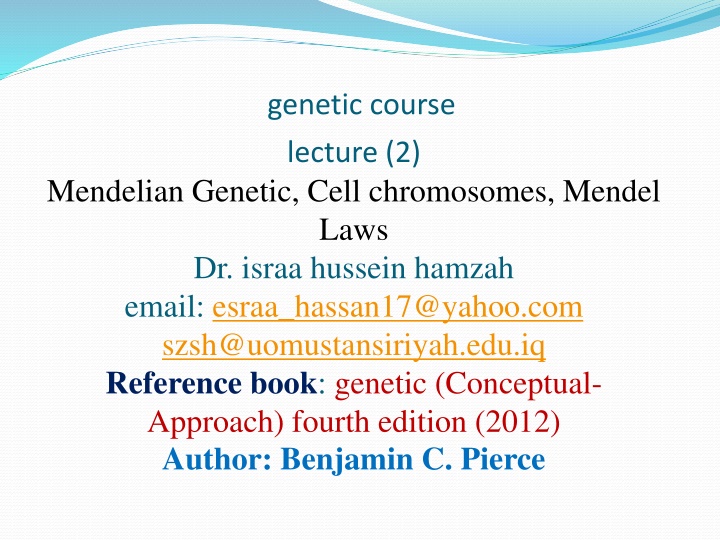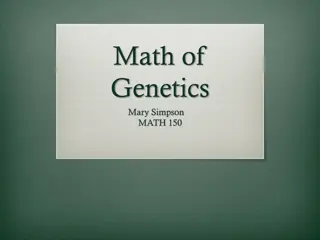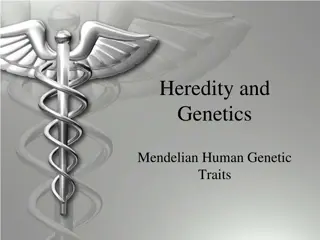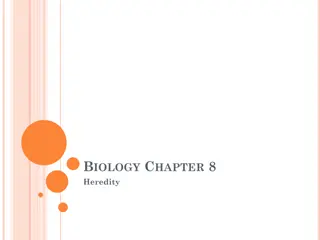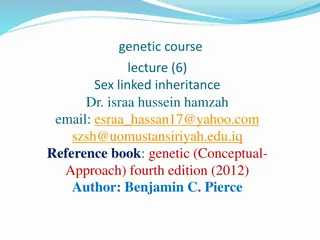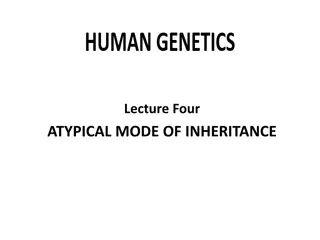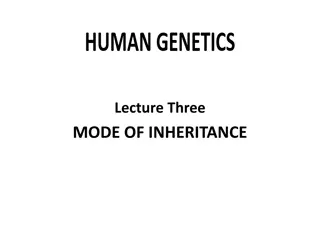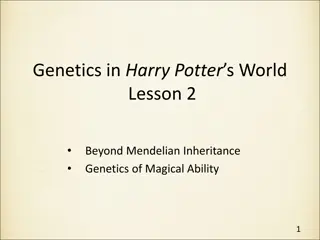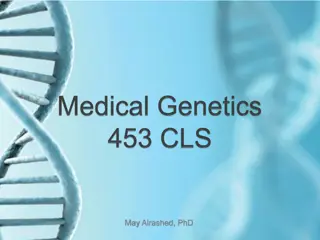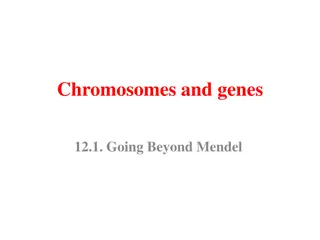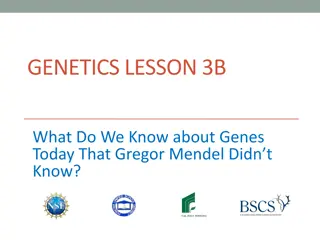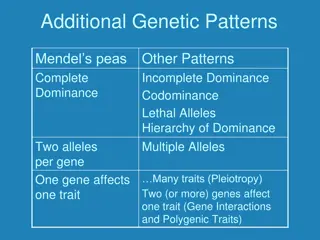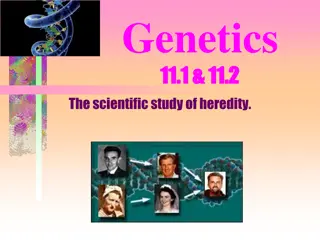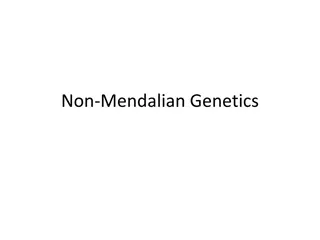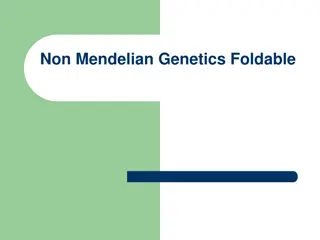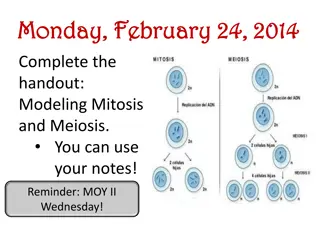Mendelian Inheritance and the Rediscovery of Mendel's Work
Mendelian inheritance, based on Gregor Mendel's laws proposed in the 19th century, laid the groundwork for modern genetics. Despite initial neglect, Mendel's work was rediscovered in 1900 after notable developments in biology. This historical overview highlights Mendel's contributions and the journey to recognizing his pivotal role in genetics.
Download Presentation

Please find below an Image/Link to download the presentation.
The content on the website is provided AS IS for your information and personal use only. It may not be sold, licensed, or shared on other websites without obtaining consent from the author.If you encounter any issues during the download, it is possible that the publisher has removed the file from their server.
You are allowed to download the files provided on this website for personal or commercial use, subject to the condition that they are used lawfully. All files are the property of their respective owners.
The content on the website is provided AS IS for your information and personal use only. It may not be sold, licensed, or shared on other websites without obtaining consent from the author.
E N D
Presentation Transcript
genetic course lecture (2) Mendelian Genetic, Cell chromosomes, Mendel Laws Dr. israa hussein hamzah email: esraa_hassan17@yahoo.com szsh@uomustansiriyah.edu.iq Reference book: genetic (Conceptual- Approach) fourth edition (2012) Author: Benjamin C. Pierce
Mendelian inheritance: is a type of biological inheritance that follows the laws originally proposed by Gregor Mendel in 1865 and 1866 and re-discovered in 1900. and he is generally recognized today as the father of genetics. The rise of the science genetic In 1676, Nehemiah Grew (1641 1712) reported that plants reproduce sexually by using pollen from the male sex cells. With this information, a number of botanists began to experiment with crossing plants and creating hybrids, including Gregor Mendel (1822 1884), who went on to discover the basic principles of heredity. In 1859 Charles Darwin Discovery: Natural Selection and wrote On the Origin of Species by Means of Natural Selection, or the Preservation of Favored Races in the Struggle for Life.
Mendel and His Work Johann Mendel was the pioneer of classical geneticists .He was born in July 22,1822 in Heinzendorf in Austrian Silesia, where his father, Anton Mendel was the owner of a small farm. In 1862, Mendel became a founding member of the Brunn Natural Science Society. On February 8, 1865, he delivered his first lecture on pea experiments to Brunn Natural Science Society. In 1866 his paper Experiments on plant hybridization published in volume 4 of the proceedings of the Natural Science Society. In the same year, he began experiments with other plant species. In this paper, Mendel proposed some basic genetic principles. But unfortunately his remarkable piece of work remained unattended and unappreciated up to 1900. , There were several reasons for the sad neglect of Mendel's work. These include 1- biologist's preoccupation with speculation concerning Darwin's theory of evolution origin of species which appeared in 1859 2- obscurity of the journal in which Mendel published his results;
REDISCOVERY OF MENDEL'S WORK Mendel's research paper remained dormant and unnoticed by the scientific world until 1900. During these intervening thirty four years many developments occurred in biology which prepared the way for the rediscovery of Mendel's work. For instance, during this period Haeckel (1866) recognised the active role of nucleus in heredity; Weismann, Hertwig, Strasburger and Kolliker suspected active participation of chromosomes in heredity transmission. Roux (1883 suggested that the chromosomes must contain qualitatively different hereditary determiners arranged in linear orders. Weismann supported the idea of Roux by propounding his germplasm theory
Further, some workers such as Darwin (1868) in England Vilmorin (1879) in France, Rumpau (1891) in Germany and Bohlin (1897) in Sweden carried out hybridization experiments, very much like Mendel, on different plants and observed the phenomenon of dominance, but they failed to provide any conclusive explanation to their findings. It was in the beginning of 20th century that three botanists, namely Hugo de Vries, working on Oenothera; Carl Correns working on Xenia, peas and maize and Erich von Tschermak working on various flowering plants, independently drawn the conclusions like Mendel. Later these botanists came across the research paper of Mendel and rediscovered it in 1900. Mendel s original paper was republished in Flora, 89, 364 (1901). Bateson confirmed Mendel s work by a series of hybridization experiments. and he is generally recognized today as the father of genetics.
Genetic terminology Before we examine Mendel s crosses and the conclusions that he drew from them, a review of some terms commonly used in genetics will be helpful
MENDELS SELECTION OF THE EXPERIMENTAL PLANT. For his hybridization experiments Mendel had certain consideration in his mind about the choice of a suitable material. Mendel s considerations about the material were as follows 1-Variation. The organisms which are to be chosen for the genetical experiments, should have a number of detectable differences and at a time only single detectable character should be considered. 2- .Reproduction. The chosen organisms should be sexually reproducing 3-Controlled mating. 4-Short life cycle. 5-Large number of offspring. 6-Convenience in handling. The experimental species should be of a type that can be raised and maintained conveniently and inexpensively in the laboratory. For instance, the elephant will prove entirely useless material for genetical experiments than the Drosophila, pea plants, tomato, rats, guinea pigs, etc., which have been generally used and are still used in hybridization experiment
Mendels success Mendel s approach to the study of heredity was effective for several reasons. Foremost was his choice of experimental subject, the pea plant Pisum sativum which offered clear advantages for genetic investigation. and Much of Mendel s success can be attributed to the seven characteristics that he chose for study. He avoided characteristics that display a range of variation; instead, he focused his attention on those that exist in two easily differentiated forms, stem may be tall or dwarf, cotyledons may be green or yellow; seeds may be round or wrinkled, seed coat may be coloured or colourless; the unripe pods may be green or yellow; the ripe pods may be inflated or constricted between the seeds, flowers may have axial or terminal positions and the colors of flowers may be red or white. Finally, Mendel was successful because he adopted an experimental approach and interpreted his results by using mathematics. Unlike many earlier investigators who just described the results of crosses,
Pea shape (round or wrinkled) Pea color (green or yellow) Pod shape (constricted or inflated) Pod color (green or yellow) Flower color (purple or white) size (tall or dwarf) Position of flowers (axial or terminal)
Besides these contrasting characters, the pea plant is a very satisfactory material for the hybridization experiments due to its flower structure. The flowers of pea plants are so constructed that the pollens of a flower normally fall on the stigma of the same flower and, thus, affects self-pollination or self-fertilization. For the required cross-pollination, the anthers have to be removed from the flower in bud stage (i.e., before their maturity). This operation of removal of anthers is called emasculation. The stigma is protected against any foreign pollen with the help of its covering by a bag. The pollen, then at the dehiscence stage is brought from the plant to be used as a male parent and by the help of a brush is dusted on the feathery stigma of the emasculated flower. At the time of such cross pollination, the pollen should be mature and stigma should be receptive.
Principle of Segregation Mendel started with 34 varieties of peas and spent 2 years selecting those varieties that he would use in his experiments. He verified that each variety was pure- breeding (homozygous for each of the traits that he chose to study) by growing the plants for two generations and confirming that all offspring were the same as their parents. He then carried out a number of crosses between the different varieties. Although peas are normally self-fertilizing (each plant crosses with itself), Mendel conducted crosses between different plants by opening the buds before the anthers (male sex organs) were fully developed, removing the anthers, and then dusting the stigma (female sex organs) with pollen from a different plant s anthers Mendel began by studying monohybrid crosses those between parents that differed in a single characteristic. In one experiment, Mendel crossed a pure- breeding (homozygous) pea plant for round seeds with one that was pure-breeding for wrinkled seeds . This first generation of a cross is the P (parental) generation After crossing the two varieties in the P generation, Mendel observed the offspring that resulted from the cross.
The offspring from the parents in the P generation are the F1 (filial 1)generation. When Mendel examined the F1 generation of this cross, he found that they expressed only one of the phenotypes present in the parental generation. all the F1 seeds were round he planted the F1 seeds, cultivated the plants that germinated from them, and allowed the plants to self-fertilize, producing a second generation the F2 (filial 2) generation. Both of the traits from the P generation emerged in the F2 generation; Mendel counted 5474 round seeds and 1850 wrinkled seeds in the F2. He noticed that the number of the round and wrinkled seeds constituted approximately a 3 to 1 ratio; that is, about 3/4 of the F2 seeds were round and 1/4 were wrinkled. Mendel conducted monohybrid crosses for all seven of the characteristics that he studied in pea plants and, in all of the crosses, he obtained the same result: all of the F1 resembled only one of the two parents, but both parental
The presence of both round and wrinkled seeds in the F2 could be explained only if the F1 plants possessed both round and wrinkled genetic factors that they had inherited from the P generation. He concluded that each plant must therefore possess two genetic factors encoding a character. The genetic factors (now called alleles) that Mendel discovered are, by convention, designated with letters; the allele for round seeds is usually represented by R, and the allele for wrinkled seeds by r. The plants in the P generation of Mendel s cross possessed two identical alleles: RR in the round-seeded parent and rr in the wrinkled-seeded parent The second conclusion that Mendel drew from his monohybrid crosses was that the two alleles in each plant separate when gametes are formed, and one allele goes into each gamete. When two gametes (one from each parent) fuse to produce a zygote,
However, only the trait encoded by the round allele (R) was observed in the F1: all the F1 progeny had round seeds. Those traits that appeared unchanged in the F1 heterozygous offspring Mendel called dominant, and those traits that disappeared in the F1 heterozygous offspring he called recessive. When dominant and recessive alleles are present together, the recessive allele is masked, or suppressed. The concept of dominance was the third important conclusion that Mendel derived from his monohybrid crosses.
The conclusions that Mendel developed about inheritance from his monohybrid crosses have been further developed and formalized into the principle of segregation and the concept of dominance. The principle of segregation (Mendel s first law) states that each individual diploid organism possesses two alleles for any particular characteristic. These two alleles segregate (separate) when gametes are formed, and one allele goes into each gamete. Furthermore, the two alleles segregate into gametes in equal proportions. The concept of dominance states that, when two different alleles are present in a genotype, only the trait encoded by one of them the dominant allele is observed in the phenotype. Upper case letters are traditionally used to denote dominant traits, lower case letters for recessives
Summary of Mendel's Results: 1. Each individual Before meiosis (Mendel s organism possesses first law) two alleles encoding a trait. 2. Alleles separate Anaphase I when gametes are formed. 3. Alleles separate in Anaphase I equal proportions Mendel's law of segregation the two alleles for each trait separate (segregate )during gamete formation and then unite at random one from each parent, at fertilization
Dihybrid cross In addition to his work on monohybrid crosses, Mendel crossed varieties of peas that differed in two characteristics a dihybrid cross. For example, he had one homozygous variety of pea with seeds that were round and yellow another homozygous variety with seeds that were wrinkled and green. When he crossed the two varieties, the seeds of all the F1 progeny were round and yellow. He then self-fertilized the F1 and obtained the following progeny in the F2 : 315 round, yellow seeds; 101 wrinkled, yellow seeds; 108 round, green seeds; and 32 wrinkled, green seeds. Mendel recognized that these traits appeared approximately in a 9 : 3 : 3 : 1 ratio; that is, 9/16 of the progeny were round and yellow, 3/16 were wrinkled and yellow, 3/16 were round and green, and 1/16 were wrinkled and green.
Mendel carried out a number of dihybrid crosses for pairs of characteristics and always obtained a 9 : 3 : 3 : 1 ratio in the F2. This ratio makes perfect sense in regard to segregation and dominance if we add a third principle, which Mendel recognized in his dihybrid crosses: the principle of independent assortment (Mendel s second law). This principle states that alleles at different loci separate independently of one another
